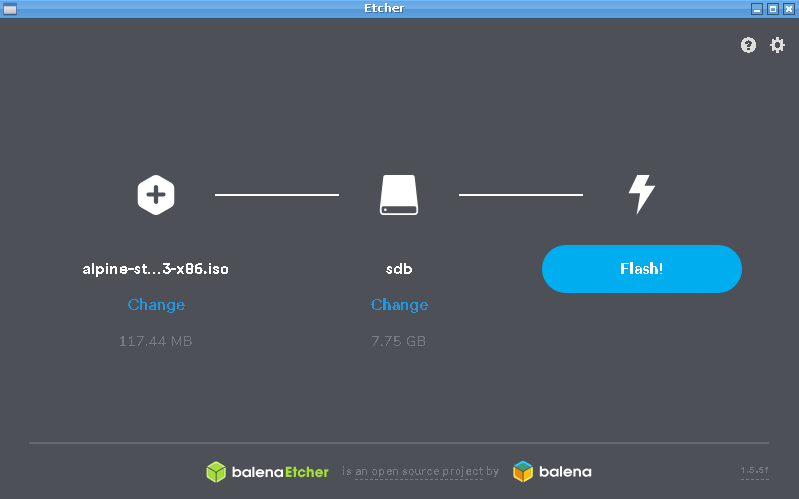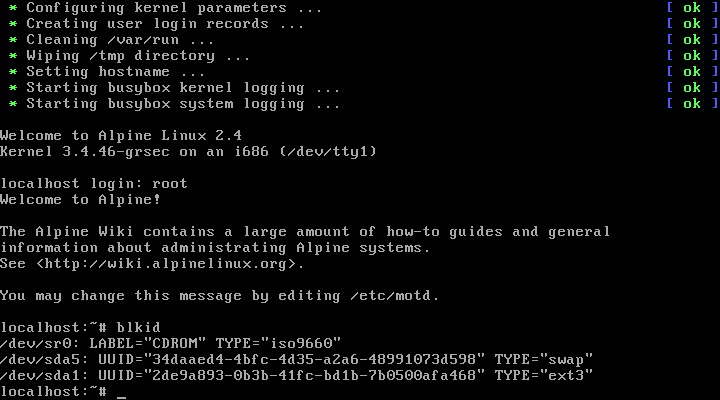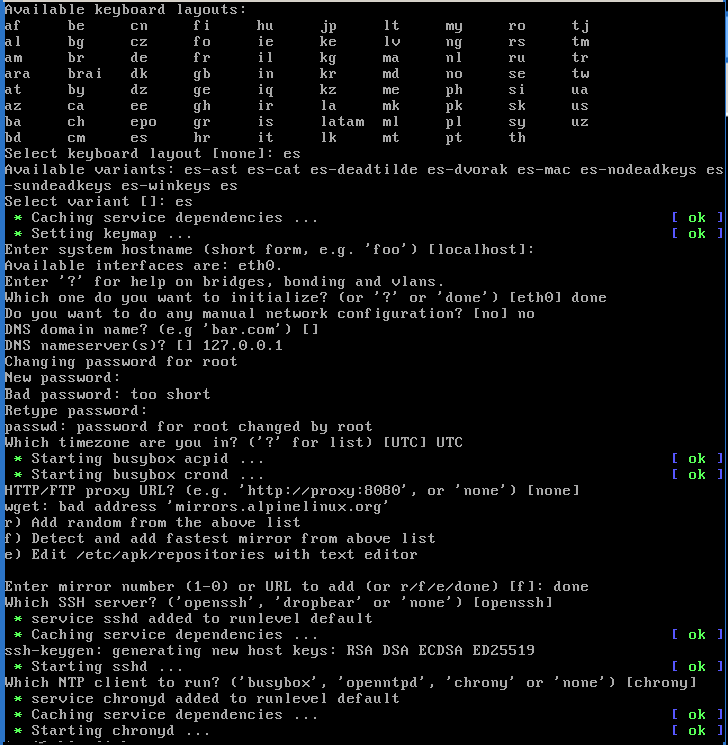mirror of
https://codeberg.org/alpine/alpine-wiki.git
synced 2023-08-25 13:53:16 +02:00
174 lines
8.1 KiB
Markdown
174 lines
8.1 KiB
Markdown
|
|
# Alpine Install: from a USB to any computer without internet and only alpine boot
|
||
|
|
|
||
|
|
**Overall description:** Alpine Installation from a official iso,
|
||
|
|
dumpet to a usb source device media, and installed to a bare metal computer
|
||
|
|
no matter if include [UEFI](Alpine_and_UEFI.md) and will be the only OS
|
||
|
|
installed to boot, the networking configuration will happened AFTER you install
|
||
|
|
the operating system, so you can configure it with more detail.
|
||
|
|
|
||
|
|
Means you will **install Alpine as the only OS in a PC computer from USB BUT OFFLINE** media.
|
||
|
|
|
||
|
|
And.. **after boot up the new operating system, you will put apk files to setup wifi**
|
||
|
|
|
||
|
|
> **Warning** This method only works for most modern pc vbeyond 2016 and recents.
|
||
|
|
|
||
|
|
## Requirements
|
||
|
|
|
||
|
|
- A usb stick to write the ISO source media file downloaded
|
||
|
|
- In the new machine we need support for booting from USB devices
|
||
|
|
- In the new machine we need at least 512Mb of RAM, 2Gb prefered.
|
||
|
|
- IF you dont have internet but still have network disconected or no cable
|
||
|
|
|
||
|
|
## Downloading the source medium to install
|
||
|
|
|
||
|
|
In this case, **your PC wil have [UEFI or must be beyond 2016's](Alpine_and_UEFI.md#where-i-will-find-bios-based-devices)**
|
||
|
|
you will need **64-bit iso EXTENDED, if you dont use extended version your will need internet networking**,
|
||
|
|
the download URL will be:
|
||
|
|
|
||
|
|
`http://dl-cdn.alpinelinux.org/alpine/v3.17/releases/x86_64/alpine-extended-3.17.3-x86_64.iso`
|
||
|
|
|
||
|
|
> **Warning** you must use extended ISO file, if not you will be forced to have internet.
|
||
|
|
|
||
|
|
**How to download usin Graphical browser**: point the web browser to
|
||
|
|
that url and the download of the iso file will start. A file with **.iso**
|
||
|
|
extension type, will be downloaded commonly into the Download directory.
|
||
|
|
|
||
|
|
**How to download usin Command line method**: in unix-like terminal (MAC/Linux) execute:
|
||
|
|
`cd $HOME;wget -c -t8 --no-check-certificate http://dl-cdn.alpinelinux.org/alpine/v3.17/releases/x86_64/alpine-standard-3.17.3-x86_64.iso`,
|
||
|
|
and unless the case of GUI, your **.iso** file wil be direclty in your home directory.
|
||
|
|
|
||
|
|
> **Warning** The 3.17.0 release ISO has a bug, does not included the need pacakges for offline install.
|
||
|
|
|
||
|
|
## Writing the source medium to your USB
|
||
|
|
|
||
|
|
Using [balena-etcher-electron](https://www.balena.io/etcher/) to flash the USB
|
||
|
|
drive from any system, its easy, simple and available for all OSs.
|
||
|
|
|
||
|
|
> ***Warning** this guide assume only one hard drive as `/dev/sda` and only one USB as `/dev/sdb`
|
||
|
|
|
||
|
|
* download the `program balena-etcher-electron` (there are portable versions)
|
||
|
|
* Run the program `balena-etcher-electron` as root in the graphical session
|
||
|
|
* Click "select image" icon, open the downloaded image file
|
||
|
|
* Plug the USB drive into the computer, it will automatically show as `sdb`
|
||
|
|
* After it balena-etcher-electronshows the USB as “sdb”, clickflash
|
||
|
|
* Wait a while and when finished, close the program
|
||
|
|
* Take out the USB and place it on the installation target computer in a port
|
||
|
|
|
||
|
|
> **Note** this method only works on recent MacOs 10.12+ or recent Linux 4.9+ installations
|
||
|
|
|
||
|
|

|
||
|
|
|
||
|
|
You can also made it manually, open your terminal program, move to the place
|
||
|
|
directory where ISO downloaded are placed and `cp` to the USB device:
|
||
|
|
|
||
|
|
> umount /dev/sdb; cp alpine-standard-3.17.0-x86_64.iso /dev/sdb
|
||
|
|
|
||
|
|
## Booting the Alpine USB media
|
||
|
|
|
||
|
|
When the machine start, you must be sure to choose the right booting drive
|
||
|
|
(commonly named USB boot drive or USB hard disk), so the disc/iso will boot and after a
|
||
|
|
while a command line shell will show you:
|
||
|
|
|
||
|
|
> **Note** When starting Alpine it will ask for the login, just typing root and pressing enter allows you to start:
|
||
|
|
|
||
|
|

|
||
|
|
|
||
|
|
> **Warning** Tip: If your system is not configured to boot from a USB drive, it must be
|
||
|
|
configured in the BIOS/UEFI, **ask/search to your vendor or technical support**, Toshiba
|
||
|
|
computers need to hit F1 to choose boot medium, DELL must hit F11 to choose medium for
|
||
|
|
example, and so and so
|
||
|
|
|
||
|
|
## Installing after boot up
|
||
|
|
|
||
|
|
> **Warning** if you do not download the extended ISO it may require internet.!!!
|
||
|
|
|
||
|
|
#### runing the setup script
|
||
|
|
|
||
|
|
After entering the root environment and gets the console prompt installation media,
|
||
|
|
you must perform these commands, that will:
|
||
|
|
|
||
|
|
* prepare disk sizes, boot partiton to 500 megs
|
||
|
|
* perpare swap sices, swap partition to 2 Gigs
|
||
|
|
* and run setup script to configure and process instalation:
|
||
|
|
|
||
|
|
```
|
||
|
|
export BOOT_SIZE=500
|
||
|
|
|
||
|
|
setup-alpine
|
||
|
|
```
|
||
|
|
|
||
|
|
This will start some questions, these are in the following order:
|
||
|
|
|
||
|
|
* keyboard and variant, example for Latin is esand afteres-winkeys
|
||
|
|
* hostname: just hit enter, it's the name of the computer.
|
||
|
|
* Network options: write `done` cos you dont have internet and has no sense
|
||
|
|
* DNS Options: dont write anything, leave blank and write `none` for the domain
|
||
|
|
* Time zone options: Just use the suggested defaults, just hit enter.
|
||
|
|
* Proxy Options: Use `none` in this case, please
|
||
|
|
* NTP Options: Use `chrony` the packet already in the middle.
|
||
|
|
* Enter mirror number: here due lack of network internet just write "done"
|
||
|
|
* SSH Options: Use `openssh` the package that already comes in the middle.
|
||
|
|
* Alow root login: write `yes` cos we will changed later.
|
||
|
|
* Enter the ssh URL: just write `none` or just hit enter
|
||
|
|
* Disk Options: Use `sda` as the entire hard drive present will be used.
|
||
|
|
* Mode: Select `sys` to install the system on disk.
|
||
|
|
|
||
|
|
After answering `sys` to the questions about the drive, and since there will only
|
||
|
|
be one drive, answering `sda` on which drive to use, this will create and leave
|
||
|
|
your hard drive as follows:
|
||
|
|
|
||
|
|
* `/dev/sda1` as BOOT in 500Mb in `/boot`
|
||
|
|
* `/dev/sda2` as SWAP in 4Gb
|
||
|
|
* `/dev/sda3` as ROOT in 200Gb in `/` (approximately or rest of space available)
|
||
|
|
|
||
|
|
In a few minutes everything will be ready to use ofering a console when boot new system.
|
||
|
|
|
||
|
|

|
||
|
|
|
||
|
|
## Finishing the installation
|
||
|
|
|
||
|
|
After all of the scripts in the setup end, a "reboot" will be offered,
|
||
|
|
just type "reboot" and press enter, remove the boot media and newly
|
||
|
|
installed system will be booted.
|
||
|
|
|
||
|
|
**You cannot see a graphical window system? take it easy** and get
|
||
|
|
calmed down.. in Alpine all are made by the right way.. so **if user
|
||
|
|
need a desktop.. user can install a desktop**
|
||
|
|
|
||
|
|
## The wifi setup after install
|
||
|
|
|
||
|
|
Please follo the guiude [alpine-tutorial-wifi-routering.md](alpine-tutorial-wifi-routering.md),
|
||
|
|
you will need to download the needed packages manually from another device
|
||
|
|
and then but it on the installed Alpine computer using USBstorage external device.
|
||
|
|
|
||
|
|
## How to use this guide
|
||
|
|
|
||
|
|
This guide is for install process, many parts will need you understand minimal
|
||
|
|
knowledge of linux.
|
||
|
|
|
||
|
|
This guide assumed you have a serial port allowed in the targeted computer, also
|
||
|
|
its important you shuold understand the way of the configuration in this guide.
|
||
|
|
|
||
|
|
> **Warning** Some Linux or/and Mac terminals have security cut/paste locks, so
|
||
|
|
if you paste, the first line will be preceded by garbage, check always the first char of your paste.
|
||
|
|
|
||
|
|
## Licensing clarifications
|
||
|
|
|
||
|
|
**CC BY-NC-SA**: the project allows reusers to distribute, remix, adapt, and build upon the material
|
||
|
|
in any medium or format for noncommercial purposes only, and only so long as attribution is given
|
||
|
|
to the creators involved. If you remix, adapt, or build upon the material, you must license the modified
|
||
|
|
material under identical terms, includes the following elements:
|
||
|
|
|
||
|
|
* **BY** Credit must be given to the creator of each content respectivelly, starting at the first contributor.
|
||
|
|
* **NC** Only noncommercial uses of the work are permitted, with exceptions if you fill an issue here!
|
||
|
|
* **SA** Adaptations must be shared under the same terms, you must obey this terms and do not change it.
|
||
|
|
|
||
|
|
https://codeberg.org/alpine/alpine-wiki/src/branch/main#license
|
||
|
|
|
||
|
|
## See also
|
||
|
|
|
||
|
|
* [README.md](README.md)
|
||
|
|
* [alpine-setup-install-script.md](../alpine/alpine-setup-install-script.md)
|
||
|
|
* [alpine-tutorial-desktop-wayland-try.md](alpine-tutorial-desktop-wayland-try.md)
|
||
|
|
* [alpine-tutorial-desktop-xfce4-fast-forward.md](alpine-tutorial-desktop-xfce4-fast-forward.md)
|